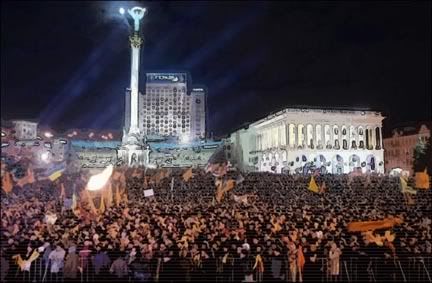Once the initial sweetness of Otpor’s example and the bloodless revolution faded, a sort of saccharine aftertaste in the Serbian mind became evident. Brian Pozun wrote for Central Europe Review in early 2001:
“Ostensibly, the movement accepted Western aid to promote their goal of a purged, democratized Serbia. When it became clear, however, that Western governments were involved, many in Yugoslavia and elsewhere began to wonder what sort of return those generous governments will want on their investment in Otpor. [1]
Citing Milosevic’s ads that had Otpor’s fist stuffed with American dollars, Pozun explains, “many are left wondering just how far off the ad really was.” In another play from Milosevic’s propaganda campaign, the President made public an intercepted, top-secret CIA plan to remove him from power by supporting Otpor and other such groups. But the paper Milosevic cited was in fact an openly available plan to unseat him by supporting and training the opposition. It was a memorandum to the US Congress, written by Daniel Server at the US Institute of Peace, recommending a trial run of Sharp’s and Helvey’s strategic nonviolence. It was Milosevic’s secret police that made the changes to make it appear secret and CIA-sponsored, and thus sinister. [2] But again, despite the creative license, the paper was otherwise presented as written, and we must wonder how far off the mark Milosevic really was.
Peace magazine in 2003 described how American support for Otpor “benefited from a temporary consistency and coherence in American foreign policy during the Clinton presidency, which actually pursued the strategies advocated by Gene Sharp.” [3] The Server letter Milosevic cited led to Congressional approval of $41-$45 million for the project (overall estimates vary). While NATO set its bomb sights, the article explains, “sanctions were applied in a more targeted fashion. For example, they were not applied to municipalities that voted to support opposition politicians.” To further the freeing of Serbian minds in other towns, Radio transmitters were set up in Eastern Europe and organized into a “Ring Around Serbia,” beaming in western media like the BBC, Agence France-Presse, and Voice of America. Other actions approved included the US Treasury Department’s freezing of Milosevic’s assets tracked down to banks in Cyprus. [4] Not being able to pay one’s security forces can’t help one’s cause.
The revelations that Otpor in fact had been part and parcel of the well-orchestrated American-led campaign that had also produced the bombings and the ‘Allo ‘Allo re-runs eroded the widely held view of Otpor as spontaneous, grass-roots people's movement. While they were still free of Milosevic and sanctions, the sunshine of public optimism was now overcast with doubts. Serbia’s youth had been co-opted into a “post-military weapons system” of the NATO campaign, a troubling precedent to ponder. Originally they had felt their country was under attack because of their leader’s wrongdoing, but now had to reflect on one of Milosevic’s last speeches; on October 2, as Otpor and the DOS “NATO foot soldiers” closed the noose on him, Milosevic explained that his people had it all backwards. “It should be clear to all, after the past ten years, that NATO isn't attacking Serbia because of Milosevic; it is attacking Milosevic because of Serbia.” [5] Just three days later the attack was complete, Milosevic was removed from the scene, and the DOS took control of Serbia and started selling it to the West.
Subscribe to:
Post Comments (Atom)


No comments:
Post a Comment